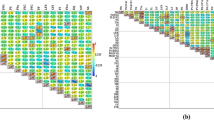Summary
Factor, Principal component and canonical analyses were used to study the extent of genetic diversity among 30 accessions of West African okra. Genetic variability among the accessions proved to be large. Pigmentation of various parts of the accessions and fruit characteristics contributed significantly to the total variation observed. Factor analysis and principal component analysis produced similar results which were substantially different from those produced by canonical analysis. The first three canonical variables accounted for 100% of the total variance while the number of pods per plant, and pod weight primarily accounted for the first canonical variable. Whereas the second canonical variable was primarily loaded by number of seeds per pod and fruit colour, the third canonical variable was comprised of a weight of 100 seeds and number of epicalyx segments.
The level of variability observed supports the opinion (Stevels, 1988, 1990) that this okra type constitutes a separate species.
Similar content being viewed by others
References
Akoroda, M. O., 1982. Phenetic similarity among Dioscorea cayenensis cultivars as estimated by cluster analysis and minimum spanning tree. Ann. Appl. Biol. 101: 547–552.
Ariyo, O. J., 1987. Multivariate analysis and the choice of parents for hybridization in okra (Abelmoschus esculentus (L.) Moench). Theor. Appl. Genet. 74: 361–363.
Ariyo, O. J., 1988. Metroglyph and index score analysis and variety distinctness in okra (Abelmoschus esculentus). Nig. J. Agron. 3: 42–46.
Ariyo, O. J., 1990. Measurement and classification of genetic diversity in okra (Abelmoschus esculentus). Ann. Appl. Biol. 116: 335–341.
Ariyo, O. J., 1992. Factor analysis of components of yield and vegetative traits in okra. Indian J. Agric. Sc. 62: 83–84.
Ariyo, O. J. & A. Odulaja, 1991. Numerical analysis of variation among accessions of okra (Abelmoschus esculentus L. Moench), Malvaceae. Ann. Bot. 67: 527–531.
Bartual, R., E. A. Carbonell & D. E. Green, 1985. Multivariate analysis of a collection of soyabeans cultivars for southeastern Spain. Euphytica 24: 113–123.
Bates, D. M., 1968. Notes on the cultivated Malvaceae 2. Abelmoschus. Baileya 26: 99–112.
Charrier, A., 1984. Genetic resources of the genus Abelmoschus Med. (Okra). IBPGR. Rome 61 pp.
Chevalier, A., 1940. L'origin, la culture et les usage de cinq Hibiscus de la section Abelmoschus. Rev. Bot. Appl. Agric. Trop., 20: 319–328.
Chheda, H. R. & C. A. Fatokun, 1982. Numerical analysis of variation patterns in okra (Abelmoschus esculentus L. Moench). Bot. Gaz. 143: 253–261.
De Candolle, A. P., 1986. Origin of cultivated plants. Hafner, New York.
Joshi, A. B. & M. W. Hardas, 1976. In: N. W. Simmonds, (Ed.) Evolution of Crop Plants. Longman. pp 194–195.
Martin, F. W., A. M. Rhodes, M. Perez & F. Diaz, 1981. Variation in okra. Euphytica 30: 697–715.
Rezai, A. & K. J. Frey, 1990. Multivariate analysis of variation among wild oat accessions—seed traits. Euphytica 49: 111–119.
Siemonsma, J. S., 1980. Bilan des etudes conduites sur le gombo. Rapport Annual, 1979–1980. Centre Neerlandais, Abidjan, I. Coast. 35: 38.
Siemonsma, J. S., 1982. West African okra-morphological and cytogenetical indications for the existence of a natural amphidiploid of Abelmoschus Esculentus L. Moench and A. manihot L. Medikus. Euphytica 31: 241–242.
Singh, H. B. & A. Bhatnagar, 1975. Chromosome number in okra from Ghana. Indian J. Genet. Plant Breed. 36: 24–27.
Sneath, P. H. A. & R. Sokal, 1973. Numerical Taxonomy. 573 pp. W. H. Freeman. San Francisco.
Stevels, J. C. M., 1988. Une nouvelle combinaison dans Abelmoschus. (Malvaceae) un gombo d'Afrique de l'Ouest et centrale. Bull. Mus. nat. Hist, nat., Paris u-ser. lo., 1988 Section B., Adansonia 2: 137–144.
Stevels, J. C. M., 1990. Légumes Traditionnelles du Cameroun, Une étude agro-botanique. Wageningen Agricultural University Papers 90-l. pp 262.
Watson, P. D., 1972. Factor analysis of yield in spring wheat (Triticum aestivum L.). Crop. Sci. 12: 731–733.
Author information
Authors and Affiliations
Rights and permissions
About this article
Cite this article
Ariyo, O.J. Genetic diversity in West African okra (Abelmoschus caillei) (A. Chev.) Stevels — Multivariate analysis of morphological and agronomic characteristics. Genet Resour Crop Evol 40, 25–32 (1993). https://doi.org/10.1007/BF00053461
Received:
Accepted:
Issue Date:
DOI: https://doi.org/10.1007/BF00053461




